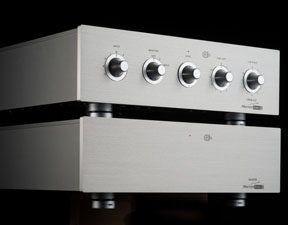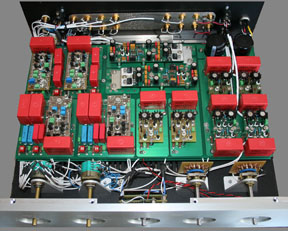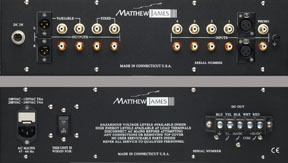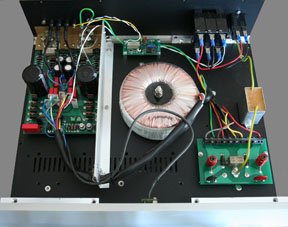Chorale Preamplifier
 The Chorale preamplifier has been designed to provide sonic quality, consistent performance and reliability, with a great deal of flexibility. Its development has centered on the desire to create an ideal analog interface unit between source components, audio recorders and amplifiers. (Read the reviews)
The Chorale preamplifier has been designed to provide sonic quality, consistent performance and reliability, with a great deal of flexibility. Its development has centered on the desire to create an ideal analog interface unit between source components, audio recorders and amplifiers. (Read the reviews)
The Chorale preamplifier is built on three levels of circuit boards. The first level is a motherboard that contains the ground and power supply routing. Extensive ground plane techniques minimize interference from radiated energies. Large printed circuit paths for DC power reduce detrimental voltage drops caused by resistance and inductance. (See owner's manual)
The second level is a second motherboard that contains precision parts and circuit wiring. The active circuitry is built on individual boards that make up the third level of circuitry and mount on standoffs made from extremely pure copper flashed with silver through which the signal flows to and from the motherboards. This practice minimizes any losses and distortions of the signal, while improving contact reliability. Non-magnetic hardware, used throughout the Chorale, insures that signal flow will not be disrupted by magnetic interference.
The Chorale has a total of six inputs including phono, a balanced line input, and four single-ended line inputs. It contains a total of ten audio amplifiers, and four power supply regulators in addition to an external power supply.
 Four (4) single-ended, line level stereo inputs, all with a 1 MegOhms input impedance, with very small amounts of capacitance in parallel for RF filtering and circuit compensation, are provided. The 1 MegOhms input buffer amplifiers allow all line level sources to perform with the lowest distortion, maximum clarity and depth of imaging. These buffer amplifiers, which accept the signal from the input selector and drive the Monitor control switch, prevent recorders or processors, connected to the Chorale’s fixed outputs, from adversely affecting the performance of line level sources.
Four (4) single-ended, line level stereo inputs, all with a 1 MegOhms input impedance, with very small amounts of capacitance in parallel for RF filtering and circuit compensation, are provided. The 1 MegOhms input buffer amplifiers allow all line level sources to perform with the lowest distortion, maximum clarity and depth of imaging. These buffer amplifiers, which accept the signal from the input selector and drive the Monitor control switch, prevent recorders or processors, connected to the Chorale’s fixed outputs, from adversely affecting the performance of line level sources.
The gain and input impedance of the phono section are programmable to accommodate any cartridge. Phono performance is advanced since the RIAA circuitry is buffered from all loading by the 1MegOhms buffer amps. The Chorale may be ordered with or without phono section activated.
There are two sets of single-ended outputs (RCA-type) and one set of balanced outputs (XLR-type) controlled by the 59-position volume control in 1dB steps. The balanced output contains four individual, discrete amplifiers for the plus and minus signals for each channel, providing Class A, symmetrical output to drive power amplifiers with balanced inputs.
 The left and right output amplifiers have switchable gain from 1 to 10dB in 1dB steps, controlled individually, by channel, from the front panel. For the most efficient systems 0dB line gain is ideal. For systems with less efficiency, or amplifier input sensitivity, 10dB gain is more appropriate. The ability to add left and right gain individually allows for channel balance control as well. From a sonic point of view, the individual gain controls permit the optimization of system performance. There are also two sets of single-ended fixed outputs, designed to drive an audio recorder or processor’s inputs, for recording and listening without compromise.
The left and right output amplifiers have switchable gain from 1 to 10dB in 1dB steps, controlled individually, by channel, from the front panel. For the most efficient systems 0dB line gain is ideal. For systems with less efficiency, or amplifier input sensitivity, 10dB gain is more appropriate. The ability to add left and right gain individually allows for channel balance control as well. From a sonic point of view, the individual gain controls permit the optimization of system performance. There are also two sets of single-ended fixed outputs, designed to drive an audio recorder or processor’s inputs, for recording and listening without compromise.
We have spent the greater part of ten years exploring various remote controls and have found nothing we could use that did not compromise the sound of the Cello 59-position output level control. Remote control of any kind diminished performance and so could not be included.
This decision, freeing us from consideration of remote control, in turn led to our being able to consider large, hand-soldered rotary switches for input selection and monitoring. These switches offer superior performance and reliability through positive indexing and electrical contact systems. While other types of switches allow for sources to be selected and volume to be controlled via remote control, none of these offer the sonic excellence of the switches chosen. Again, any convenience, which detracted from sonic performance, was not considered for inclusion in the Chorale.
The latest generation of the Cello 59-position volume control is incorporated and continues to set the standard for sonic excellence, reliability, and precision tracking as it has for more than 25 years. Since there has never been a commercially available switch which meets our requirements and performance standards, we have designed our own. Each switch uses two printed circuit boards using gold over rhodium over copper laminations and 120 individually selected resistors matched to a tolerance of 1%. The shaft, frame, arms and contact assemblies are machined to high tolerances. The contact material is guaranteed for 50 years of continual service with stable contact resistance for low noise. It features high resistance to corrosion and tarnish and was developed for guidance systems for military hardware, satellite communications and drug delivery systems. The shaft rides in two custom machined bronze bushings. The rear plate is made out of solid brass and contains 60 milled depressions which allow a precision stainless steel bearing to index each switch position.
 An important part of the Cello philosophy is found in the physical separation of the power supply from the active circuitry of either the preamplifier or the amplifier. The external Master power supply includes a mu-metal shielded transformer and an initial stage of regulation. The DC signal is again regulated within the Chorale with individual regulators for the + and – portions of both the input and output sections. Precision 10 turn trimpots allow exact calibration of tracking voltages. DC voltages are transported from the Master to the Chorale and Encore via substantial, teflon shielded, copper cables terminated with a heavy duty connector at the Chorale and with substantial copper/rhodium spades at the Master.
An important part of the Cello philosophy is found in the physical separation of the power supply from the active circuitry of either the preamplifier or the amplifier. The external Master power supply includes a mu-metal shielded transformer and an initial stage of regulation. The DC signal is again regulated within the Chorale with individual regulators for the + and – portions of both the input and output sections. Precision 10 turn trimpots allow exact calibration of tracking voltages. DC voltages are transported from the Master to the Chorale and Encore via substantial, teflon shielded, copper cables terminated with a heavy duty connector at the Chorale and with substantial copper/rhodium spades at the Master.









